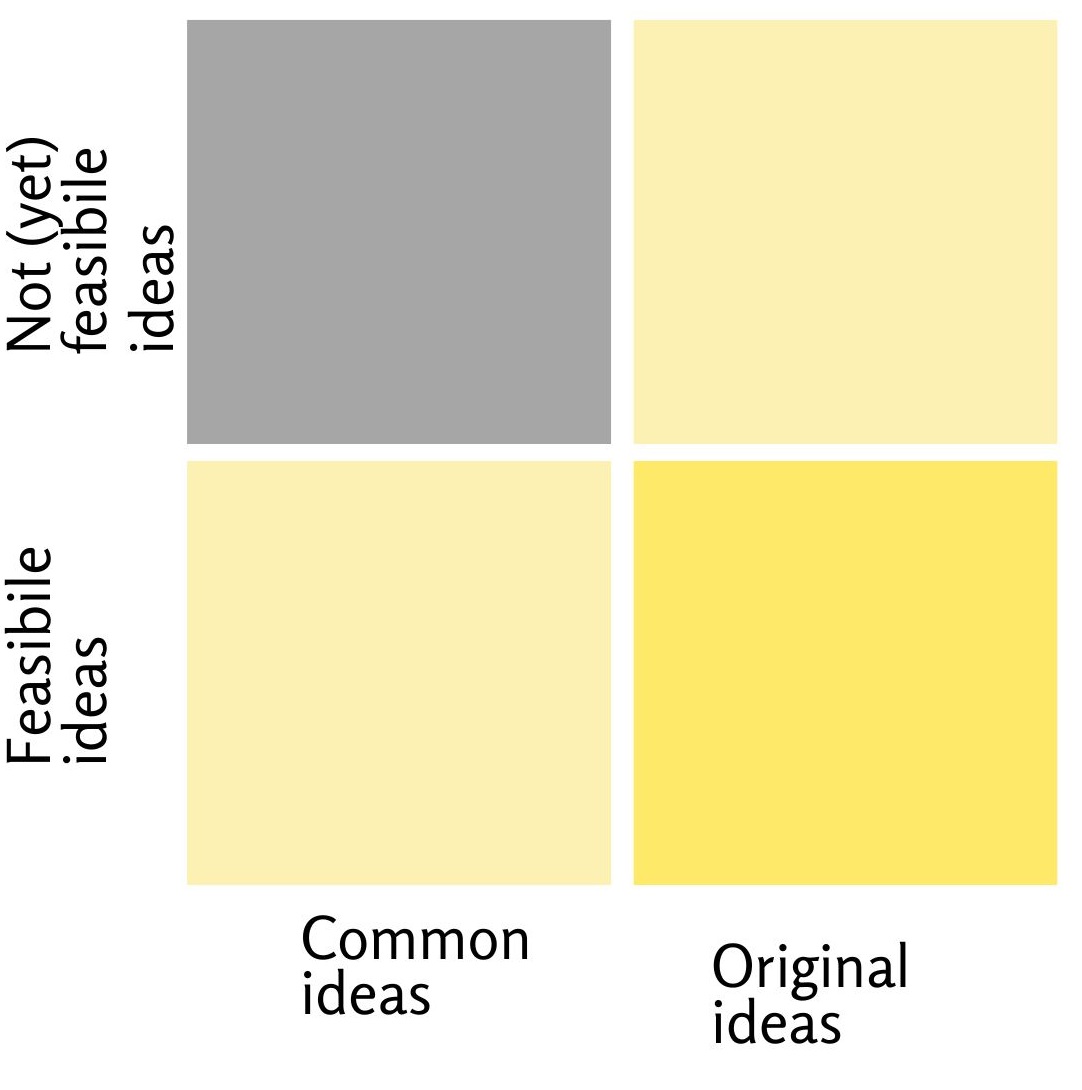Name of Method
Brief description

Type/Level of Method
Challenges
Problem, Purpose and Needs
This tool can be used to address any problem as it helps in prioritizing solutions to be implemented after an idea generation process.
Relevance to Climate Neutrality
Challenges
Thematic Areas
Impact Goals
Issue Complexity
Issue Polarisation
Enabling Condition
Essential Considerations for Commissioning Authorities
Before starting to put the ideas (written on sticky notes such as post its) into the tool, it is important for the participants to have knowledge of the whole picture of the problem they are working on, to effectively qualify an idea as feasible or not feasible, for example. If that is not possible, the person conducting the meeting should leave space for discussions after the sticky notes are placed in the template.
Engagement Journey
Governance Models and Approaches
Enabling Conditions
Democratic Purpose
Spectrum of participation
Communication Channels
Actors and Stakeholder Relationships
If possible, it is important that there are all stakeholders at the same table but it is not necessary.
Participant Numbers
Actors and Stakeholders
Participant Recruitment
Interaction between participants
Format
Social Innovation Development Stage
Scope
Time commitment
The set up for the activity depends on how many people are involved and separated in how many groups. Ideally every participant should have a chair and every group a working table. If you are doing the activity in smaller groups, they should not be more than 6 people at each table.
The time commitment for the activity itself is around 1 (one) hour.
Resources and Investments
Typical duration
Resources and Investments
In-house
Step by Step
1. Start by printing out the template for each team. Ideally you print it in A2 or A3 size.
2. First ask the group to write the ideas on sticky notes. Make sure to explain that they should write 1 idea per sticky note. If you have different groups, each group receives the same ideas.
3. Once they finish writing, introduce them to the Idea Selection template. Explain that they must place the sticky notes with their ideas on the quadrant they feel are more connected and representative of the idea. To place the sticky notes, they should assess each idea answering the following questions:
Is this idea feasible, can it be implemented?
If the answer is yes, the question will be placed on the right side of the matrix.
Is this idea original, has it not been done before?
If the answer to this question is also yes, according to the perspective of the team, then this idea will be placed on the top right. Otherwise, it should be placed on the bottom right. Similarly, ideas not assessed as feasible can be divided into the top left and bottom left squares according to their originality.
The group can either discuss each idea and come to a shared understanding while placing it or the group members can place ideas based on their individual assessment and the group can review and discuss each idea at the end. Make sure to reserve enough time for these discussions as people will have different perspectives on feasibility and originality of ideas. It is also important to decide (either you as the facilitator or the group) if people will vote on which or where the idea should be placed or if you need a consensus to move to the next idea. No matter what approach you choose, keep in mind that everyone should feel heard and contemplated to ensure buy-in and ownership for the process and future implementation.
4. Once everyone is done, explain that your focus going forward will be on the ideas that were added to the top right square. These ideas are called “ideas that will make an impact” in the tool.
If you are working with several groups, it can be very useful to have each team present their “ideas that will make an impact” and to compare among the different teams. A good idea is to rank ideas, depending on how many teams identified them as “feasible and original”.
5. Before you end the session, make sure to explain to all participants what is going to happen next with these ideas and how they can be involved. At the end, thank everyone for their contribution.
Evaluation
This tool doesn’t have a specific form of evaluation, since is qualitative and problem based. However, a good idea is to schedule a meeting for a period after using the tool to see how far you have become or if changes needed to be done during the way.
Connecting Methods
Flexibility and Adaptability
This model can be implemented by small or big groups. If you have more than 6 people participating, divide the participants into smaller groups. Each group should have 3-6 participants. Ideally, each group should have a working table and be able to work without being influenced by the conversations on other tables.
You can also do this activity online, using Jamboard, Miro or any other online collaboration tool.
Ideally, the tool is used synchronously, although it could be adapted for asynchronous conversations too.
If you have a lot of ideas to qualify, you might want to adapt the process as to give different smaller teams different ideas and present their qualification in the big group afterwards.
The amount of guidance needed depends on the profile of participants. Some might feel more comfortable in this decision making, whereas others might need to be encouraged to follow their gut feeling, whenever they lack information.
The one part that shouldn’t be changed is the 4 quadrants of the tool.
Existing Guidelines and Best Practice
Guidelines for this tool can be found in the Service Design Toolkit (https://www.servicedesigntoolkit.org/index.html) from the Flanders Service Toolkit Design.
References and Further Resources
Another good tool for prioritizing ideas is the Eisenhower Matrix (https://asana.com/pt/resources/eisenhower-matrix)
Silearning Repository https://www.silearning.eu/tools-archive/idea-selection/
Silearning pdf template https://www.silearning.eu/wp-content/uploads/2017/04/idea-selection.pdf

